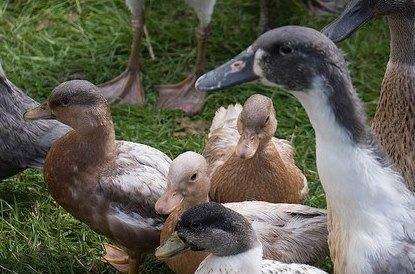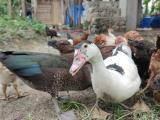Avian flu was detected in as many as five poultry flocks in France and one in Germany, while heightened surveillance in the United States recently found H5 genetic material in a mallard duck killed by a hunter in Oregon.
France had earlier reported three avian flu outbreaks, the country's first in 8 years, with Germany reporting an outbreak earlier this year.
Elsewhere, Ghana reported another H5N1 outbreak in poultry, part of an ongoing resurgence in the region that has been underway over the past year.
French outbreaks
France's outbreaks were in the southwestern part of the country, in Dordogne department, an area that saw the three earlier outbreaks were reported, and in Landes department, located southwest of there on the Atlantic coast. Official statements and media reports on the outbreaks were translated and posted by online infectious disease news sites FluTrackers, Avian Flu Diary (AFD), and ProMED Mail.
According to a statement today from the French agriculture ministry, three new highly pathogenic outbreaks were detected in Landes, affecting Guinea fowl and ducks, and in Dordogne, affecting ducks.
Officials said the outbreaks were detected during enhanced surveillance triggered by the earlier outbreaks.
An Agence-France Presse (AFP) report in French today said there were as many as five new outbreaks. So far there is no information on what flu strains were linked to the latest outbreaks.
Earlier outbreaks in Dordogne, detected at the end of November, involved a mutated H5N1 strain closely related to European low-pathogenic avian flu strains, an initial assessment found. Another was caused by H5N2, the country's first detection of the subtype, according to a report last week from the World Organization for Animal Health (OIE).
H5N2 in Germany
In Germany, meanwhile, district agriculture officials today reported a low-pathogenic H5N2 outbreak at a poultry farm near the Bavarian city of Cham, located in the southeast part of the country, according to a report in German translated and posted by AFD. Officials said culling operations were under way.
A district statement posted yesterday by ProMED Mail, the online reporting system of the International Society for Infectious Diseases, said the facility had about 12,900 poultry, including laying hens, ducks, geese, and turkeys. Earlier this year the highly pathogenic H7N7 virus hit poultry in Germany's Lower Saxony region.
Italy also recently reported an H5N2 outbreak in Emilia-Romagna region, located in the northern part of the country.
Oregon sample not enough to tell strain
The US Department of Agriculture's Animal and Plant Health Inspection Service (APHIS) noted the Oregon finding in a Dec 4 statement on its preparedness efforts, in the wake of an H5N2 outbreak in poultry that was the nation's largest-ever animal health emergency.
Last summer when the outbreak wound down, APHIS warned that the virus would likely reappear in the fall and has taken several steps to prepare, including awarding contracts for poultry vaccines for the national stockpile, in case the decision to use them is made.
No highly pathogenic avian influenza (HPAI) has been detected in the United States since Jun 17, and a Nov 18 report to the OIE said all outbreaks at commercial farms had been resolved and that the country was free of the virus.
APHIS said so far a year-long enhanced surveillance effort to test 40,000 samples has already analyzed 24,000 samples collected from hunter-harvested birds and wild birds found dead.
As part of the effort, a Eurasian H5 strain was recently found in genetic material from a hunter-harvested mallard duck, but testing wasn't able to determine the exact strain or if the virus was high- or low-pathogenic. The duck was shot in November in Oregon's Morrow County, located in the north central part of the state at the border with Washington.
The highly pathogenic H5N2 that struck North American poultry earlier this year was found to be different from the Eurasian HPAI H5N1 virus, containing genes from the Eurasian HPAI H5N8 strain as well as genes from North American low-pathogenic avian flu viruses found in wild birds.
More H5N1 in Ghana
Ghana's latest outbreak involved backyard birds in Greater Accra state, in the far south of the country. The event began on Nov 11 and involved laying hens and cockerels.
Of 600 susceptible birds, the virus killed 17, and the remaining poultry were culled as a disease control measure. Investigators haven't yet discovered the source of the virus.
A pair of H5N1 outbreaks was reported in the same region in the middle of November, according to an earlier report. Ghana has reported several H5N1 outbreaks this year, marking the first appearance of the virus there since 2007.
See also:
Dec 7 AFD post on French outbreaks
Dec 7 AFD post on German outbreak
Dec 6 FluTrackers thread
Dec 6 ProMED Mail post
Dec 4 APHIS statement
Dec 7 OIE report on Ghana outbreak





















